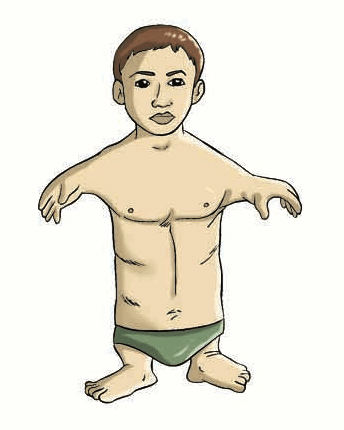2. An anomaly in which the hands or feet (or both) are attached directly to the shoulders or hips.
3. A congenital malformation (birth defect) in which the hands and feet are attached to abbreviated arms and legs.
4. Absence or markedly imperfect development of arms and forearms, thighs and legs, but with hands and feet present.
5. Etymology: a combination of Greek phoco-, "seal (flipper)" and Greek melia, "limb, extremity" to designate a human limb like a seal's flipper which is a consequence of exposure in modern times of the developing fetus to thalidomide medication.

Recent chromosomal studies have suggested that, in addition to the drug-induced anomalies, other cases of phocomelia may have a genetic basis
Phocomelia was probably recognized in the early years of Babylonian rule, because the teratologic records of Chaldea mention an infant with hands and feet like fish tails or fins.
The 1675 French edition of the surgical text of Scultetus contains an illustration of a case of phocomelia with harelip, an association that has since been observed by others.
A great reputation was achieved by malformed Marc Cazotte, who presented himself to public exhibition during the latter part of the eighteenth century, with the name Pépin. He had no arms and legs; his hands were attached to his prominent shoulders, his feet to his hips.
He was described as a clever man, with a mastery of four languages and with great manual dexterity, Pépin traveled around Europe on horseback, where he attracted large crowds. He died at the age of 62 in Paris, where his skeleton is preserved in the Musée Dupuytren.
